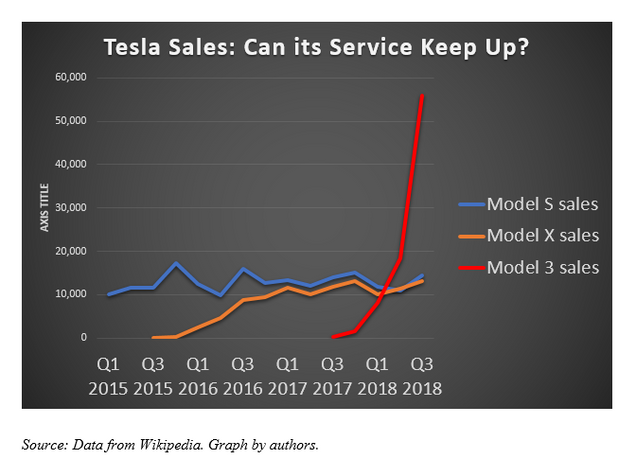Elon Musk’s Next Big Headache: Tesla Service
by Justin Ren and Xin Wang
Summary: This article looks at Tesla as a value chain, and predicts that Tesla will soon face a new constrained bottleneck in its after-sale service.
There is some good news and bad news at the production and delivery front at Tesla these days. On the good side, it seems that Tesla has finally figured out how to volume-produce its Model 3 in a sustained manner — it was reported that Tesla produced over 50,000 Model 3 in Q3 of 2018, a threshold that has been closely watched.
On the bad side, though, its founder Elon Musk openly acknowledged that it has “gone from production hell to delivery logistics hell”.
What is this “delivery logistics hell” like? We can get a glimpse at each step of its supply chain:
- Production plant: The company is running out of car carrier trailers to deliver cars to its service centers;
- Service centers: They are being overwhelmed with visitors, and they are running out of space to hold car deliveries from plants.
- Customers: Just as the original tweet (in link above) indicated, customers are experiencing longer and longer delays in their delivery.
To Tesla’s credit, it is devising multiple solutions trying to get itself out of that delivery logistics hell. The company is building its own delivery car carriers. It is re-designing its delivery network, hiring more delivery executives and workers, and is piloting a program to deliver cars directly to customers. In some of its service centers it is testing a 5-minute “Sign-and Drive” pickup process for customers to reduce congestion and speed up delivery. Musk even enlisted current Tesla owners to help out new customers in their delivery centers so they can get their cars faster.
Let’s suppose for now that Tesla will get out of its delivery and logistics hell, eventually. Will it be on its way to profitability heaven and eternal glory?
Not so fast. There may be another hell waiting.
That one is called after-sales service hell.
Using a value chain lens, it is easy to spot that Tesla’s next hellish bottleneck will be its struggle on how to service the rapidly growing number of cars and keep its vast customer base happy.
Tesla’s current service centers are designed to serve mostly Model S and Model X owners. But now with its explosive growth in production and sales of Model 3 (a cheaper model that is targeted towards the mass market), the number of customers is growing at such a rapid pace that its current service centers simply will not be able to handle the deluge of service calls that they should be expecting to get very soon.

Granted that with much fewer moving parts such as transmission or gear boxes, electric cars have much less service needs compared to gasoline-powered cars. With no gas engines, electric cars do not need regular oil changes or other maintenance jobs that are expected for gasoline cars. But still, electric cars do break down and they need to be serviced. Things could be worse for Tesla as they are new to manufacturing and that they are making new models which have never been made before. According to a 2017 Reuters report, 90% of Tesla’s Model S and Model X had some types of quality issues after assembly, compared to 10% of Toyota cars. Even if we assume for now electric cars have smaller defect rate than gasoline cars, it is simple math that with a much larger ownership base, there will be many more service requests. With each doubling of sales, there will be a doubling of service needed.
In addition, as cars age and go out of warranty (Tesla’s standard warranty is 4-years or 50,000 miles), they will experience more problems and require more services. With no authorized third-party service shops to go, those Tesla owners have no other choice than being queued up at one of Tesla’s own service centers, which are limited in number (As of this writing, Tesla lists 179 service locations worldwide on its own website). Since Tesla began volume production more or less 4 years ago, the company will start seeing a lot more of its cars requesting for out-of-warranty services going into 2019 and forward, which will exacerbate its service capacity shortage on top of the explosive service needs from new car ownership.
Clearly, Tesla’s service centers are not ready for that.
To see a preview, take a look at Norway, the leading country with the highest Tesla ownership per capita. There customers complaints are on the rise about slow service and long wait, and show signs of worsening.
There is another danger lurking in the service department. That is the potential alienation of its high-end customers (i.e. Model S and Model X owners). For the past few years, those customers with more expensive cars are used to top-notch service and free super-charging that are readily available. But now with the increasingly over-crowding at service centers, those owners will have to wait longer to get their cars serviced or repaired. They will have to tolerate noisier waiting rooms with mostly empty cookie trays and coffee pots. They will even have to wait more frequently and longer at those super-chargers when taking their trips.
How exactly those kinds of cannibalization will play out in unclear, but one thing is crystal clear: Tesla owners will have a much rougher ride in service, if the company does not take a preemptive approach and tackle its upcoming service hell immediately.
Z. Justin Ren, Ph.D., is Associate Professor in Operations and Technology Management at Boston University Questrom School of Business. Xin Wang, Ph.D. is Associate Professor in Marketing at Stonehill College.